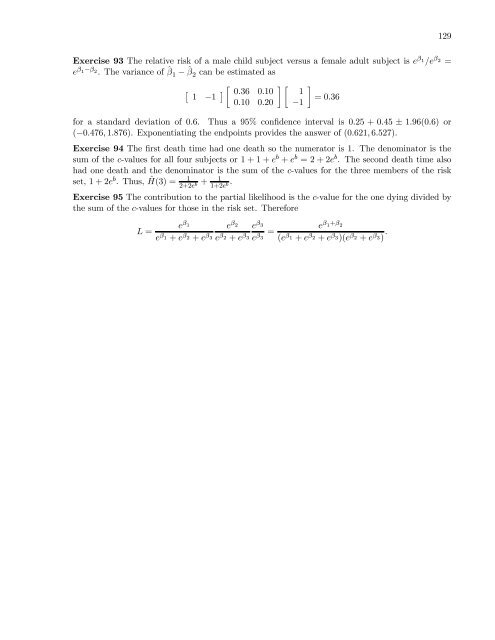Estimation, Evaluation, and Selection of Actuarial Models
Estimation, Evaluation, and Selection of Actuarial Models
Estimation, Evaluation, and Selection of Actuarial Models
You also want an ePaper? Increase the reach of your titles
YUMPU automatically turns print PDFs into web optimized ePapers that Google loves.
129<br />
Exercise 93 The relative risk <strong>of</strong> a male child subject versus a female adult subject is e β 1 /e<br />
β 2 =<br />
e β 1 −β 2 .Thevariance<strong>of</strong>ˆβ1 − ˆβ 2 can be estimated as<br />
£<br />
1 −1<br />
¤ · 0.36 0.10<br />
0.10 0.20<br />
¸·<br />
1<br />
−1<br />
¸<br />
=0.36<br />
for a st<strong>and</strong>ard deviation <strong>of</strong> 0.6. Thus a 95% confidence interval is 0.25 + 0.45 ± 1.96(0.6) or<br />
(−0.476, 1.876). Exponentiating the endpoints provides the answer <strong>of</strong> (0.621, 6.527).<br />
Exercise 94 The first death time had one death so the numerator is 1. The denominator is the<br />
sum <strong>of</strong> the c-values for all four subjects or 1+1+e b + e b =2+2e b . The second death time also<br />
had one death <strong>and</strong> the denominator is the sum <strong>of</strong> the c-values for the three members <strong>of</strong> the risk<br />
set, 1+2e b .Thus,Ĥ(3) = 1 + 1 .<br />
2+2e b 1+2e b<br />
Exercise 95 The contribution to the partial likelihood is the c-value for the one dying divided by<br />
the sum <strong>of</strong> the c-values for those in the risk set. Therefore<br />
L =<br />
e β 1 e β 2 e β 3<br />
e β 1 + e β 2 + e β 3 e β 2 + e β 3 e β 3<br />
=<br />
e β 1 +β 2<br />
(e β 1 + e β 2 + e β 3)(e β 2 + e β 3) .
















